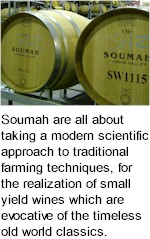


Yarra Valley was the region of choice, for its acclaim in producing cool climate, clear varietal wines with savoury elegance. The Soumah raison d�etre is to support this fame with the definitive vineyard site, nurturing viticulture and a focus on quality over quantity. The viticultural team focus on the crucible of the wine grape. Over the centuries, the noble grape varietals of the old world traveled back and forth across Europe. Viognier is a distant cousin of Nebbiolo, Savarro began its history in Bolzano but is today found in France. Pinot Gris and Pinot Noir are found in France and Italy, albeit under different styles.

It therefore widely regarded that the best practice is to continue to use clones, however plant a number of patches of different clones of the same variety. Planting the clones that have the history, provenance, style and flavour profile you want. This will create a more compelling and higher quality wine with more depth and a wider range of fragrance and taste profiles. This is a contributing factor why wines of the same variety, from the same region, can actually have different underlying flavours and characteristics.
Soumah take a supervised control philosophy in relation to viticulture practices. The French call it Lutte raisonn�e or reasoned fight. The basis for this philosophy is to reduce the use of synthetic fertilizers, pesticides, herbicides, and fungicides as these will eventually degrade the soil and make a weaker vine.
It is also about a well managed vine structure that helps reduce spray levels. Shoot thinning regimens are a practice designed to manage yield, balance crop, improve canopy structure and ventilation and reduce the need to spray.
The reduction of sprays not only contributes to the health of vines and the greater ecosystem, but also to the health of the winegrowers. Soumah have experimented to reduce herbicides by mulching the vine row, the success of this will see the continuation of mulching on a progressive basis across the entire vineyard. This has the combined benefit of reducing evaporation in the summer and promoting a softer and more sustainable soil profile. The winemaking at Soumah is all about taking a modern scientific approach to traditional farming techniques. The small team of dedicated professionals practise a regimen of holistic, environmentally sound agricultural techniques, for the realization of small yield wines which are evocative of the timeless old world classics.

























